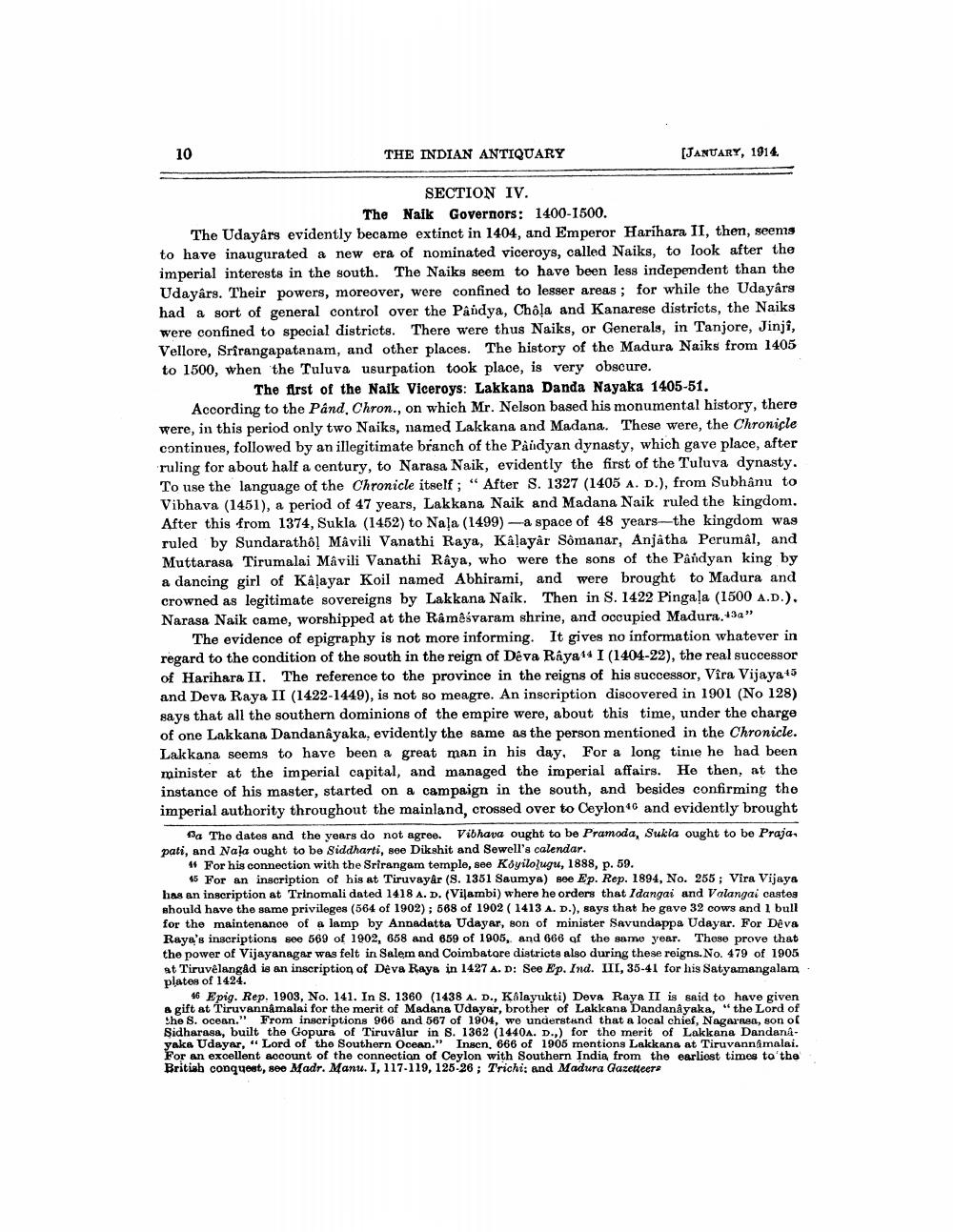________________
THE INDIAN ANTIQUARY
(JANUARY, 1914.
SECTION IV.
The Naik Governors: 1400-1500. The Udayars evidently became extinct in 1404, and Emperor Harihara II, then, seems to have inaugurated a new era of nominated viceroys, called Naiks, to look after the imperial interests in the south. The Naiks seem to have been less independent than the Udayârs. Their powers, moreover, were confined to lesser areas ; for while the Udayars had a sort of general control over the Pândya, Chola and Kanarese districts, the Naiks were confined to special districts. There were thus Naiks, or Generals, in Tanjore, Jinji, Vellore, Srirangapatanam, and other places. The history of the Madura Naiks from 1405 to 1500, when the Tuluva usurpation took place, is very obscure.
The first of the Naik Viceroys: Lakkana Danda Nayaka 1405-51. According to the Pand. Chron., on which Mr. Nelson based his monumental history, there were, in this period only two Naiks, named Lakkana and Madana. These were, the Chronicle continues, followed by an illegitimate branch of the Paidyan dynasty, which gave place, after ruling for about half a century, to Narasa Naik, evidently the first of the Tuluva dynasty. To use the language of the Chronicle itself; "After S. 1327 (1405 A. D.), from Subhanu to Vibhava (1451), a period of 47 years, Lakkana Naik and Madana Naik ruled the kingdom. After this from 1374, Sukla (1452) to Nala (1499)-a space of 48 years--the kingdom was ruled by Sundarathô! Mâvili Vanathi Raya, Kalayar Sômanar, Anjatha Perumal, and Muttarasa Tirumalai Mavili Vanathi Raya, who were the sons of the Pandyan king by a dancing girl of Kalayar Koil named Abhirami, and were brought to Madura and crowned as legitimate sovereigns by Lakkana Naik. Then in S. 1422 Pingala (1500 A.D.). Narasa Naik came, worshipped at the Râmêśvaram shrine, and occupied Madura.+3a"
The evidence of epigraphy is not more informing. It gives no information whatever in regard to the condition of the south in the reign of Deva Raya 44 I (1404-22), the real successor of Harihara II. The reference to the province in the reigns of his successor, Vira Vijaya+5 and Deva Raya II (1422-1449), is not so meagre. An inscription discovered in 1901 (No 128) says that all the southern dominions of the empire were, about this time, under the charge of one Lakkana Dandanayaka, evidently the same as the person mentioned in the Chronicle. Lakkana seems to have been a great man in his day. For a long tinie he had been minister at the imperial capital, and managed the imperial affairs. He then, at the instance of his master, started on a campaign in the south, and besides confirming the imperial authority throughout the mainland, crossed over to Ceylon' and evidently brought
Ba The dates and the years do not agree. Vibhava ought to be Pramoda, Sukla ought to be Praja, pati, and Nala ought to be Siddharti, soe Dikshit and Sewell's calendar.
41 For his connection with the Srirangam temple, see Koyilolugu, 1888, p. 59.
45 For an inscription of his at Tiruvayar (S. 1351 Saumya) see Ep. Rep. 1894, No. 255 ; Vira Vijaya has an inscription at Trinomali dated 1418 A.D. (Vilambi) where he orders that Idangai and Valangai castos should have the same privileges (564 of 1902): 568 of 1902 ( 1413 A. D.), says that he gave 32 cows and 1 bull for the maintenance of a lamp by Annadatta Udayar, son of minister Savundappa Udayar. For Deva Raya's inscriptions see 569 of 1902, 658 and 659 of 1905, and 666 of the same year. These prove that the power of Vijayanagar was felt in Salem and Coimbatore districts also during these reigns.No. 479 of 1905 at Tiruvélangad is an inscription of Deva Raya in 1427 A. D: See Ep. Ind. III, 35-41 for his Satyamangalam plates of 1424.
46 Epig. Rep. 1903, No. 141. In S. 1360 (1438 A. D., KAlayukti) Deva Raya II is said to have given a gift at Tiruvannamalai for the merit of Madana Udayar, brother of Lakkana Dandanayaka, "the Lord of Shos, ocean." From inscriptions 966 and 567 of 1904, we understand that a local chief, Nagarna, son of Sidharasa, built the Gopura of TiruvAlur in S. 1362 (1440A. D..) for the merit of Lakkana Dandantvako Udayar. "Lord of tho Southern Ocean." Inscn. 666 of 1905 mentions Lalkana at Tiruvannamalai. For an excellent account of the connection of Ceylon with Southern India from the earliest times to'tha Britisb conquest, see Madr. Manu. I, 117-119, 125-26 ; Trichi; and Madura Gazetteere




